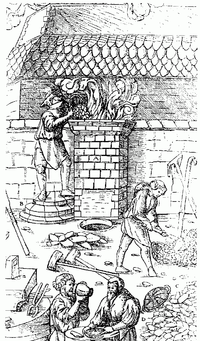
Photo from wikipedia
With the continuous improvement of the quality of steel for social development, high-quality iron ore resources have been gradually depleted. Meanwhile, the scrap steel reserve and recycling volume are gradually… Click to show full abstract
With the continuous improvement of the quality of steel for social development, high-quality iron ore resources have been gradually depleted. Meanwhile, the scrap steel reserve and recycling volume are gradually increasing, which will result in the continuous increase of the residual tin content in steel, which seriously restricts the improvement of steel quality and the circulation-utilization of scrap. Therefore, it is necessary to remove as much tin as possible in the ferrous metallurgy process. However, tin in steel cannot be effectively removed in the conventional smelting process. In this paper, the origination, the existing forms, and the content control levels of the residual tin in steel are presented, as well as the current processes of tin removal in the ferrous metallurgy process.
Journal Title: Metals
Year Published: 2019
Link to full text (if available)
Share on Social Media: Sign Up to like & get
recommendations!